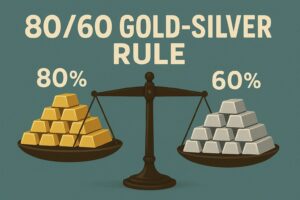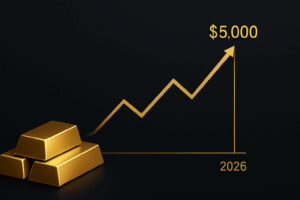
Investors often assume gold moves in sync with the stock market — but the data tells a different story. Gold’s correlation to stocks is far lower than most people realize, and that difference can dramatically improve portfolio stability. By examining gold volatility data and the forces driving its price, we uncover why gold behaves so differently — and why that’s exactly what investors need.
According to World Gold Council volatility data, gold has consistently shown less price fluctuation than equities, commodities, or even many bonds. This low correlation is part of why gold tends to rise when other assets stumble — especially during periods of financial stress, inflation, or geopolitical turmoil.
The Hidden Power of Low Correlation
Correlation measures how two assets move relative to each other. A correlation of 1.0 means they move together perfectly; -1.0 means they move in opposite directions. Over the last two decades, gold’s correlation to the S&P 500 has hovered near 0.1–0.3 — almost negligible.
That means when stocks fall, gold doesn’t necessarily follow. Instead, it often holds its value — or even rises — as investors seek safety.
For example:
- During the 2008 financial crisis, the S&P 500 plunged more than 35%, while gold gained nearly 6%.
- In 2020’s pandemic shock, gold climbed over 25%, even as global markets briefly collapsed.
This behavior isn’t coincidence — it’s structural. Gold’s drivers differ fundamentally from those of equities.
Different Drivers, Different Behavior
The drivers of gold prices are rooted in global macroeconomics and monetary policy — not corporate earnings or growth forecasts. Stocks depend on profits, consumer demand, and GDP growth. Gold, meanwhile, responds to:
- Real interest rates — When rates fall below inflation, gold tends to strengthen.
- Currency debasement and inflation fears — Gold’s purchasing power historically endures when paper money weakens.
- Systemic risk — Banking stress, geopolitical conflict, or monetary instability push investors toward assets without counterparty risk.
Because these forces operate independently from the stock market, gold often zigzags where stocks zag — creating balance when investors need it most.
Volatility: The Quiet Strength of Gold
Many investors assume gold is extremely volatile — but relative to equities and commodities, its price swings are more moderate. According to the World Gold Council’s volatility data, gold’s typical annualized volatility tends to sit below that of global equities and commodities.
While exact numbers vary by time period and frequency (daily, monthly, yearly), our analysis of historical market data suggests gold has annualized volatility in the low double-digits range, compared with teens to mid-20s for equities and even higher volatility for commodity sectors.
This comparatively steadier behavior gives gold a dual character: in times of market stress, it can act as a risk hedge, and over long horizons, it preserves value. That blend of stability and upside potential helps gold protect purchasing power while offering long-term growth.
Why This Matters for Investors
Portfolio theory 101: diversification isn’t about owning more things — it’s about owning different things. Gold is one of the few assets that truly behaves differently.
Even a modest allocation (5–10%) can:
- Reduce overall portfolio volatility
- Enhance long-term risk-adjusted returns
- Provide liquidity when other assets are under stress
That’s why institutions, pension funds, and even central banks hold gold — not for speculation, but for stability.
The Takeaway
Gold’s correlation to stocks is lower than most investors think — and that difference matters. In a world of rising uncertainty, mounting debt, and shifting monetary policy, gold continues to prove its value as the ultimate portfolio stabilizer.
When everything else moves together, owning something that doesn’t can make all the difference.
Investing in Physical Metals Made Easy
Open an AccountPeople Also Ask
Why doesn’t gold move with the stock market?
Gold’s price is driven by different factors than stocks — including interest rates, inflation expectations, and currency strength. Because these drivers operate independently of corporate earnings and growth, gold often moves in the opposite direction of equities.
How correlated is gold to the S&P 500?
Historically, gold’s correlation to the S&P 500 has been very low — typically between 0.1 and 0.3, meaning it moves largely independently. During major market downturns, that correlation can even turn negative, making gold a strong diversifier for investors seeking balance.
Is gold less volatile than stocks?
Yes. According to World Gold Council data, gold’s long-term volatility is usually lower than that of global equities and commodities. This steadier performance helps gold serve as both a store of value and a risk hedge during financial uncertainty.
How much gold should I have in my portfolio?
Many financial professionals and studies suggest allocating 5–10% of a portfolio to gold or precious metals. The right amount depends on your risk tolerance, investment goals, and time horizon — GoldSilver offers educational tools to help you find the right balance for your needs.
What happens to gold when the stock market crashes?
When markets fall sharply, investors often turn to gold for safety. Historically, gold prices have held steady or even risen during equity selloffs, such as in 2008 and 2020. This makes gold a valuable hedge when traditional assets are under stress.








